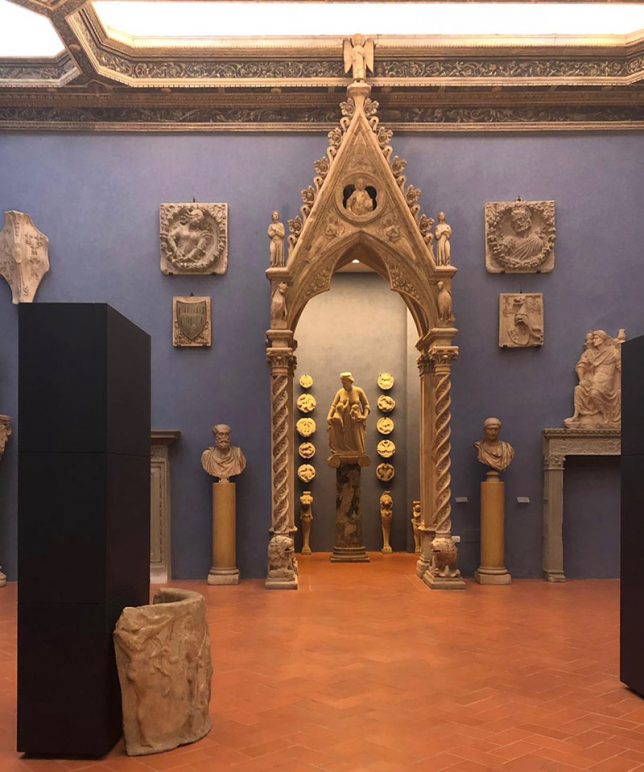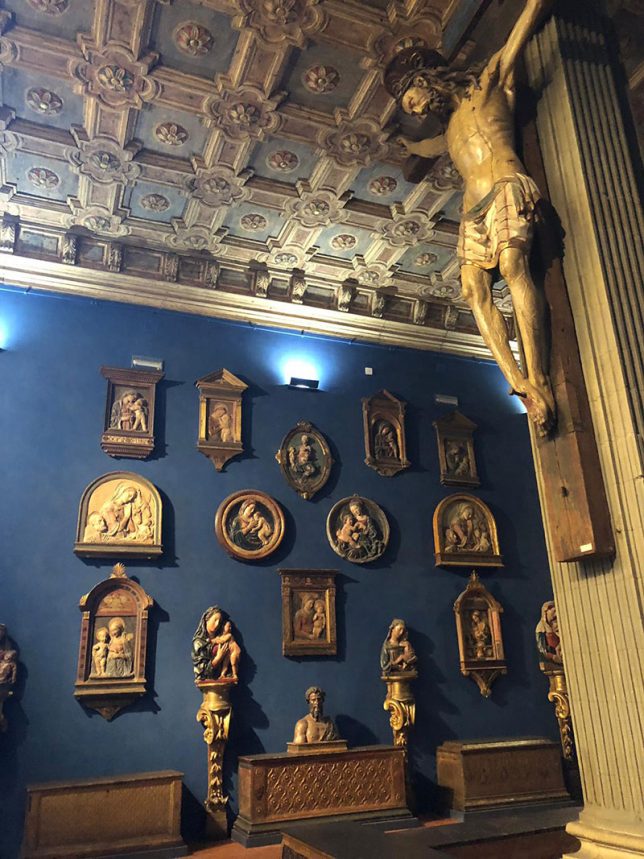
Bardini Museum – Florence
The Stefano Bardini Museum
The Collection of the Prince of Antiquarians
By Lorenzo Orsini and Camilla Torracchi (Università di Firenze)
The Stefano Bardini museum is located in piazza de’ Mozzi in Florence, in the San Niccolò Oltrarno neighborhood.
The story of this museum is closely tied to Stefano Bardini, a key figure of the international antiquities market between the 19 th and 20 th centuries. Despite having been trained as a painter, Bardini distinguished himself as a restorer and art dealer. Thanks to the success of his business he was able to purchase the ex-convent of San Gregorio alla Pace, the home of today’s museum, and use the space as an exhibition gallery, transforming it into a neo-renaissance
palace.
The enormous quantity of the works in his possession led the dealer to develop an exhibiting system that would best enhance his collection. According to installations dictated by his imagination, Bardini united works of different age and nature in the same environment. At the same time tight sales rhythms led him to continuously change the arrangement of the works: sculptures, tapestries, stone fragments and archeological objects were set up together with balance and aesthetic order in a constant search for a better type of display.
His criteria of display garnered notable success, so much so that many of his clients were attracted by the entire artistic atmosphere that they could admire in the rooms of the building.
The walls were painted with a cornflower blue, noted as ‘Bardini blue’, that was greatly admired by important collectors and art historians of the period like Nélie Jacquemart who used it in his palace, the future Jacquemart-André Museum, and Isabella Stewart Gardner who chose it for the display of her collections in Boston.
On the eve of the First World War, Bardini closed his showroom and dedicated himself to his private collection until his death, in 1922, when he bequeathed it to the city and it became part of the Civic Museums of Florence. The collection was opened to the public in 1925, but substantial changes were made, for example many of the works were moved into storage and the walls were whitewashed.
Thanks to the project curated by the current director, Antonella Nesi, through a profound study of photographic and paper documentation, the museum today represents the Bardini Gallery according the layout conceived by the antiquarian himself.
Like visitors of the time, today the public can walk through the rooms letting themselves be transported by the eclectic setting: the rooms are dominated by a criterion of symmetry. The works are displayed in an aesthetic order consistent with the immediate understanding of the object and at the same time valorizing its characteristics.
Present in every room are explanatory panels in both English and Italian. These offer visitors information on the history of the gallery and the individual works displayed allowing the public to understand where they come from and how they were added to the collection.
One of the most notable rooms is the so-called Room of Charity which houses sculptural objects from the Roman period to the 17 th century. The painted wooden ceiling, its coffers transformed into skylights radiating light throughout the room, contribute a luminous lighting effect. The back wall houses a small space, called the Chiostrina, in which is held the famous statue of Charity by Tino da Camaino, sculpted in the second decade of the 14 th century.
Between the ground floor and first floor of the museum, the visitor gains access to the mezzanine. Surrounding a Tuscan crucifix from the second half of the 15 th century, suggestively leaning on a pillar of pietra serena, is an important collection of terracotta Madonnas and wedding chests. Bardini’s attention to artisanal details of the Renaissance, however, culminates in the next room, called the Room of the Frames, decorated with a surprising variety of frames
and objects made from gilt leather.
At the end of the first-floor hallway, the public finds themselves in the center of the hall of paintings. Here the works of great masters fill the walls, and yet again one remains entranced by the variety of eras and styles. Just to name a few one can see the detached frescoes by
Giovanni da San Giovanni, the wooden crucifix by Bernardo Daddi and the Martyrdom of Saint Christina attributed to Tintoretto.
In the path leading to the conclusion of the visit, one can see how the same staircase was decorated to host the prestigious collection of antique oriental carpets, the value of which amounted to a small fortune in the antiquities market of the end of the 19 th century.
Thus, the Stefano Bardini Museum offers visitors the possibility to get to know a unique and rare collection of objects through the filter and taste of the beginning of the 20 th century. The public, strolling through the rooms, can identify themselves with the great collectors of a century ago who visited Florence to get to know, and at times buy, the beautiful objects of the ‘Prince of Antiquities.’
Translation by Marie-Claire Desjardin (Istituto Lorenzo de’ Medici)

Museo Bardini – Firenze
Il Museo Stefano Bardini
La collezione del Principe degli antiquari
Di Lorenzo Orsini e Camilla Torracchi (Università di Firenze)
Il Museo Stefano Bardini si trova in piazza de’ Mozzi a Firenze, nel quartiere di San Niccolò Oltrarno.
La storia di questo museo è strettamente legata alla figura di Stefano Bardini, personalità cardine del mercato antiquario internazionale a cavallo fra Ottocento e Novecento. Pur avendo ricevuto una formazione di pittore, Bardini si contraddistinse per la sua professione di restauratore e mercante di opere
d’arte. Grazie al successo della sua impresa, acquistò l’ex convento di San Gregorio alla Pace, sede dell’odierno museo, e lo adibì a galleria espositiva, trasformandolo in un vero e proprio palazzo neo-rinascimentale.
La grande quantità di opere possedute, spinse il mercante ad elaborare un sistema espositivo in grado di valorizzare al meglio la sua collezione. Secondo allestimenti in cui dominava la sua fantasia, Bardini univa in uno stesso ambiente opere di natura ed epoca diversa. Al tempo stesso, i ritmi serrati di vendita lo portavano a cambiare continuamente la disposizione delle opere: sculture, arazzi, frammenti lapidei e manufatti archeologici venivano allestiti insieme con equilibrio e ordine estetico in una costante ricerca di
una migliore tipologia espositiva.
I suoi criteri di allestimento ebbero un notevole successo, tanto che molti suoi clienti erano attratti dall’intero ambiente artistico che potevano ammirare nelle sale del palazzo. Le pareti erano tinte con un blu fiordaliso, noto come “blu Bardini”, che fu molto apprezzato da importanti collezionisti e storici dell’arte dell’epoca come Nélie Jacquemart che lo utilizzò nel suo palazzo, futuro Museo Jacquemart-André, e Isabella Stewart Gardner che lo scelse per l’allestimento delle sue collezioni a Boston.
Alla vigilia della Prima Guerra Mondiale, Bardini chiuse il suo showroom ed iniziò a dedicarsi alla sua collezione privata che alla morte, nel 1922, lasciò in eredità alla città e divenne parte dei Musei Civici di Firenze. La collezione fu aperta al pubblico nel 1925, ma furono apportate modifiche sostanziali, ad esempio molte opere furono spostate nei depositi e le pareti scialbate.
Grazie al progetto curato dall’attuale direttrice, Antonella Nesi, attraverso uno studio approfondito della documentazione fotografica e cartacea, il Museo oggi presenta la Galleria Bardini secondo l’allestimento pensato dal mercante stesso.
Come i visitatori dell’epoca, oggi il pubblico può passeggiare fra le sale lasciandosi rapire dagli eclettici allestimenti: domina nelle sale un criterio di simmetria. Le opere sono esposte quindi secondo un ordine estetico che consente un’immediata comprensione dell’oggetto e allo stesso tempo ne valorizza le sue caratteristiche.
In ogni stanza sono presenti pannelli esplicativi, in lingua inglese e italiana. Questi offrono al visitatore informazioni sulla storia della galleria e sulle singole opere esposte, permettendo così al pubblico di conoscere da dove provengono e quando sono giunte nella collezione.
Una delle sale più note è la cosiddetta Sala della Carità che ospita oggetti scultorei dall’epoca romana al Seicento. Il soffitto ligneo dipinto, privato dei lacunari, irradia di luce tutta la sala, contribuendo ad un effetto di illuminazione originale. La parete di fondo ospita un piccolo ambiente, detto la Chiostrina, al cui interno spicca la famosa statua della Carità di Tino da Camaino, realizzata nel secondo decennio del XIV secolo.
Tra il piano terra e il primo piano del museo, il visitatore accede al mezzanino. Attorno ad un crocifisso di ambito toscano della metà del XV secolo, suggestivamente appoggiato ad un pilastro in pietra serena, ruota un’importante collezione di Madonne in terracotta e di cassoni nuziali. L’attenzione da parte di Bardini per aspetti dell’artigianato rinascimentale trova però il culmine nella sala successiva, detta Sale delle Cornici, allestita con una sorprendente varietà di cornici e di oggetti realizzati in cuoio dorato.
Al termine del corridoio del primo piano, il pubblico si ritrova al centro del salone dei dipinti. Qui opere di grandi maestri scandiscono le pareti, e ancora una volta si rimane estasiasti dalla varietà di epoche e di stili.
Solo per citarne alcuni si possono vedere gli affreschi staccati di Giovanni da San Giovanni, il crocifisso ligneo di Bernardo Daddi o Il Martirio di Santa Cristina attribuito al Tintoretto.
Nel percorso che porta alla conclusione della visita, si può vedere come lo stesso scalone è stato adibito ad ospitare la pregevole collezione di antichi tappeti orientali, i quali ebbero un’enorme fortuna nel mercato antiquario di fine Ottocento.
Il museo Stefano Bardini offre così ai visitatori la possibilità di conoscere una raccolta di opere unica e rara, attraverso il filtro e il gusto del mercato antiquario di primo Novecento. Il pubblico, passeggiando nelle sale, potrà immedesimarsi nei grandi collezionisti che un secolo fa visitavano Firenze per conoscere, e
all’occorrenza comprare, le bellezze del “Principe degli Antiquari”.
Traduzione di Camilla Torracchi (Università di Firenze)
Photo courtesy Camilla Torracchi